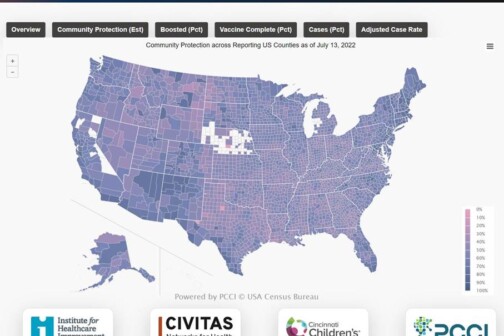“Total hospitalizations are remaining steady, so the number of patients with COVID-19 doesn’t matter.”
“Reporting the increasing percentage of COVID-19 positive patients is just fear-mongering clickbait. The hospitals aren’t anymore full than they were months ago.”
“These patients are in the hospital with COVID, not because of it. Stop scaring everyone.”
These are all comments I get from those who like to dig into the COVID-19 numbers and think we are paying too much attention to it. Maybe they are sick of reading stories about healthcare workers claiming they are overworked and stretched thin. After all, hospitals are about as full as they have been for months. If a hospital has 100 hospitalized patients either way, does it matter how many happen to have COVID-19? So why all the drama now?
In Trauma Service Area E, a 19 county area that comprises most of North Texas, the number of hospitalized patients has been hovering around 13,000 for weeks. Hospitals and ICUs have been more than 90 percent full for months. But the omicron variant has increased the percentage of total patients with COVID-19 during this time. DFW Hospital Council President and CEO reported this week that 27.4 of all hospitalized patients and 44.5 percent of adult ICU patients have been diagnosed with COVID-19. That doesn’t mean they are hospitalized because of the severity of their COVID-19 infection, but more patients testing positive means more work for everyone.
The reason healthcare workers make so much of increasing COVID-19 cases, even if the number of people who die and are hospitalized from COVID-19 (rather than with COVID-19), is because it is about 2-3 times as much work to care for a patient with COVID-19, no matter why they ended up in the hospital.
Suppose a patient comes into the hospital for a broken arm and tests positive for COVID-19. In that case, they are no longer treated as a patient with just a broken arm, says Dr. Joseph Chang, Parkland Health and Hospital System’s chief medical officer. Instead, they are now subject to a much more involved protocol that can double or triple the amount of time it takes to care for them. Compound that with a healthcare worker shortage that predated the pandemic and increasing absences due to the contagiousness of the omicron variant, and it is easier to understand why hospitals make much of increasing percentages of patients with COVID-19.
When a patient tests positive for COVID, no matter why they are in the hospital, the room has to become a room with negative air pressure, meaning the pressure outside of the room is greater than inside it. This ensures that the virus, which spreads mainly through the air and droplets, can’t spread throughout the hospital from this room. That is step one.
Next, the hospital does its best to decrease the number of people who are exposed to the patient. There are food services, custodial services, nursing, dieticians, physicians, and other healthcare workers in a normal hospital room, who are likely to come through a room to check on and care for the patient. To reduce the number of exposures, nurses often have to pick up the slack. This means they could be bringing in meals, taking out the trash, cleaning the patients, and doing other duties reserved for other workers on top of their regular duties. These extra duties also increase the documentation time for the nurses.
Those who need to enter the hospital room wear full PPE, including face masks, gowns, gloves, and shoe covers. If the patient weren’t COVID positive, they would still wear a mask, but the rest of the protective gear could be avoided.
The disease itself can cause an increase in work, even if the patient is in the hospital for something else. If a patient comes in for treatment of liver disease but has COVID-19, the respiratory therapists are often called in to make sure that oxygen levels remain healthy. Oxygen intake may need to be modified or increased if the disease worsens. This added layer of treatment and monitoring wouldn’t be necessary if the patient didn’t test positive for COVID.
And of course, if the disease becomes severe, they become a classic COVID patient, with all of the extra care involved in fighting intense versions of the virus.
Even if the COVID-19 remains mild or without symptoms, the hospital has to do a more detailed cleaning of the room when the patient leaves, and the patient is transported from their room in a way to decrease potential exposure. That means more PPE for those walking the patient out.
“It could double or triple the amount of time it takes them to document all those things,” Chang says. “That’s extra time for the staff and extra resources.”
The logistical hurdles are extensive when a patient tests positive for COVID-19 but equally important, Chang says, is the mental toll this takes on those whose job it is to be put in harm’s way. “It’s difficult when you walk into a room with someone who has a known disease that you can get so easily, and you can take home to your family, as opposed to walking into a room of a patient who has heart disease or broken arm,” Chang says. “You know you’re taking care of them, but you can’t beat that problem. It’s fully indescribable if you haven’t done it yourself.”
Fortunately for Parkland, 97 percent of its healthcare workers are vaccinated. The hospital went ahead with a vaccine mandate despite Governor Greg Abbott’s executive order trying to stop the mandate. The Supreme Court struck down the OSHA rule requiring all employers with more than 100 employees to vaccinate their employees but said healthcare organizations that receive funding from the federal government could require vaccination. Parkland was confident that would be the final ruling and went ahead with the mandate.
The final stressor is a future one. The hospitals are nearly full, as they have been for months. A significant number of those patients are in the hospital because of COVID (most of them unvaccinated), which means those are beds that could be taken up for other patients who cannot get in because their issue is not as pressing.
That delayed care may not need acute care at the moment, and the problem may not have an impact for several years. With COVID-19 taking up so much more of the limited healthcare resources, there may be consequences down the road for the entire health system.
“Our beds are critical for taking care of health problems down the road, not just COVID,” Chang says. “I can’t take care of things heart disease and diabetes as well right now with COVID-19 dominating the entire community.”





